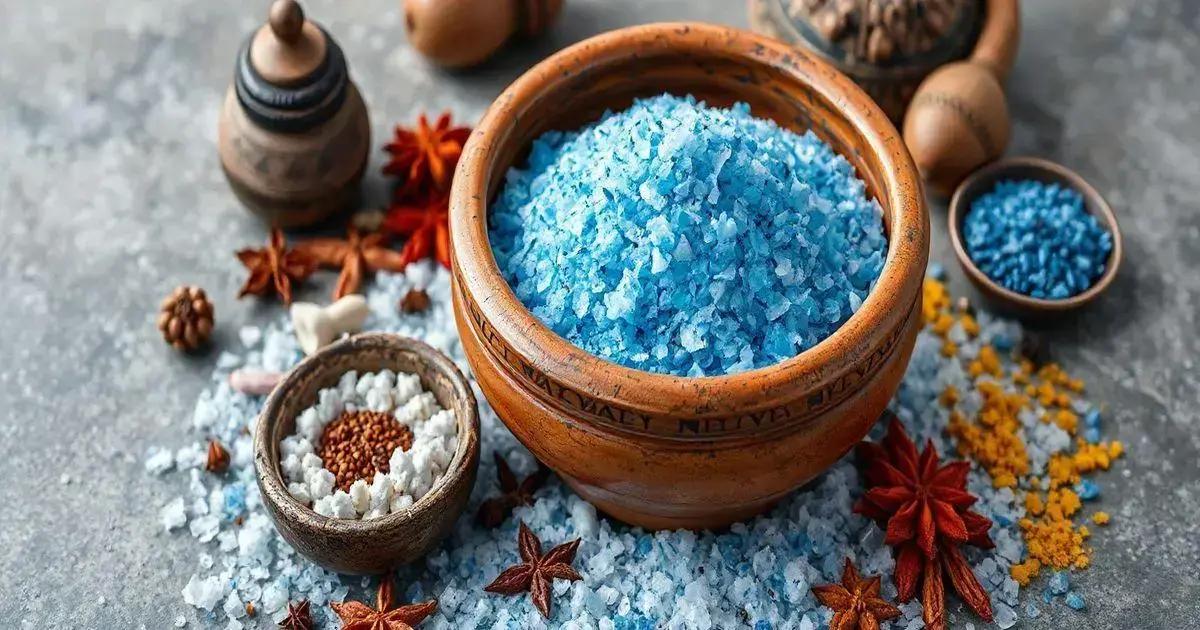The Blue Salt Trick refers to the unique culinary practice of using blue salt, known for its distinct flavor and rich mineral content, to enhance the taste of various dishes. Originating from ancient salt mines in Persia, blue salt adds visual appeal and depth of flavor when used on meats, vegetables, and even desserts, while also holding cultural significance as a symbol of wealth and tradition.
Have you ever wondered about the intriguing question, “What is the origin of the Blue Salt Trick?” This unique culinary technique has captured the fascination of chefs and food enthusiasts alike. By delving into the history, functionality, and cultural significance of blue salt, we can uncover the layers of this flavorful mystery. In this article, we will explore the origins, how this trick is applied in cooking, and its relevance in various cultures. Buckle up for a flavorful journey.
The History Behind Blue Salt

The origin of blue salt can be traced back to ancient cultures where salt was a valuable commodity. Different regions, including Persia and the Himalayas, are known for their unique salt varieties, including the striking blue salt. This special type of salt, scientifically known as Persian blue salt or Kala Namak, is often associated with its rich mineral content and distinct flavor, setting it apart from regular table salt.
Historical Significance
Throughout history, salt has played a crucial role not only in preserving food but also in trade and cultural practices. Blue salt was particularly prized in ancient Persia, where it was seen as a delicacy. The vivid color of the salt made it desirable for culinary uses and rituals.
Geographical Roots
The most famous blue salt comes from ancient salt mines in Iran, especially those in the Selim Basin. These mines have been a source of blue salt for centuries, sustaining local economies and contributing to cultural traditions. This connection to the land gives blue salt its unique identity.
Modern Rediscovery
In recent years, blue salt has enjoyed renewed interest among gourmet chefs and food enthusiasts. Its vibrant color adds a touch of elegance to dishes, while its unique taste enhances flavors. As culinary trends shift towards using natural and artisanal ingredients, blue salt has found its way into kitchens worldwide.
Exploring the history behind blue salt reveals much about its significance in culture, trade, and gastronomy. The journey from the ancient mines to modern tables showcases the enduring allure of this captivating ingredient.
How the Blue Salt Trick Works

The Blue Salt Trick is a fascinating culinary technique that enhances flavors in cooking. This trick utilizes blue salt to elevate various dishes in unique ways. Below, we break down how it works.
Understanding the Salt’s Properties
Blue salt has distinct mineral content, which contributes to its unique flavor profile. Unlike regular salt, blue salt’s minerals can interact with the natural flavors of food, creating a balanced taste. This is one reason chefs seek it out for special dishes.
The Method of Application
To use the Blue Salt Trick, the chef sprinkles a small amount of blue salt onto the dish during cooking or just before serving. This allows the salt to enhance the existing flavors without overpowering them. The vibrant color also adds visual appeal to the plate.
Best Practices for Use
When using blue salt, it’s important to start with a little. The unique flavors can be quite strong, so adding too much can lead to an overpowering taste. Pair blue salt with fresh herbs or acidic elements like lemon to create a delightful contrast.
Experimenting in the Kitchen
This trick is not limited to one type of cuisine. Chefs have found that blue salt works wonders with meats, vegetables, and even desserts. Those who enjoy cooking should feel free to experiment and discover new combinations of flavors, making the most of this special ingredient.
Through this understanding of how the Blue Salt Trick works, culinary enthusiasts can unlock a new dimension of flavors in their dishes, making mealtime a truly enjoyable experience.
Culinary Uses of Blue Salt

Blue salt is not just a visually appealing ingredient; it also offers a wide range of culinary uses that can enhance various dishes. Below are some notable applications of blue salt in modern cooking.
Seasoning Meat
One of the most popular uses of blue salt is in seasoning meats. Whether you’re grilling steak or roasting chicken, a sprinkle of blue salt can bring out the natural flavors. Its unique minerals can add depth and enhance the overall taste, making the dish more delicious.
Flavoring Vegetables
Blue salt can also elevate the flavor of roasted or sautéed vegetables. A pinch of this vibrant salt can provide a delightful contrast to the fresh, earthy notes of vegetables like asparagus, carrots, and bell peppers. Pairing it with olive oil and herbs creates a savory side dish.
Enhancing Seafood Dishes
When it comes to seafood, blue salt works wonders. It complements the delicate flavors of fish and shellfish without overpowering them. Whether used in a marinade or as a finishing touch, blue salt can make the dish stand out on any plate.
Adding to Desserts
Interestingly, blue salt can even find its way into desserts. Chefs have experimented with adding small amounts to chocolate or caramel dishes to create a delightful sweet and salty contrast. This technique can enhance flavors and surprise guests with an unexpected twist.
Overall, the culinary uses of blue salt are versatile and provide a unique way to spice up your cooking. By incorporating this special ingredient, you can create memorable dishes that pop with flavor.
The Cultural Significance of Blue Salt

The cultural significance of blue salt spans various regions and traditions, making it a fascinating topic. This salt’s unique attributes have given it a special place in many cultures.
Symbol of Wealth and Status
In ancient Persia, blue salt was highly prized and often reserved for royalty and the wealthy. Its rarity and beautiful color made it a symbol of status. People would use it as a decoration on their tables during feasts and celebrations, showcasing their affluence.
Traditional Practices and Rituals
Blue salt is often included in traditional dishes and rituals, especially in Middle Eastern cultures. It is sometimes used in ceremonial cooking and special family gatherings. These practices tie the ingredient to cultural heritage and community bonding.
Influence on Art and Cuisine
Beyond cooking, blue salt has inspired local artists and chefs. Its vibrant hue can be seen in artistic representations of food, as chefs create appealing presentations. The beauty of blue salt has sparked creativity, blending culinary skills with artistic expression.
Modern Culinary Trends
In recent years, blue salt has gained popularity among chefs worldwide. It embodies a movement towards using natural, artisanal ingredients in modern cuisine. Chefs appreciate its role in enhancing flavors while celebrating cultural history within contemporary meals.
As we explore the cultural significance of blue salt, we find that it is not merely a seasoning; it represents a tapestry of history, status, and a connection to the culinary arts.
The Fascinating Journey of Blue Salt
In summary, the exploration of blue salt reveals its rich history, culinary versatility, and cultural significance. From its ancient origins and unique properties to its modern-day applications in cooking, blue salt captivatingly enhances flavors in diverse dishes.
As we have seen, the blue salt trick isn’t just a culinary technique; it reflects the wealth of history and artistry behind its use. By incorporating this ingredient into your cooking, you not only elevate flavors but also embrace a tradition that spans cultures and generations.
Blue salt serves as a reminder of the connection between food and culture, enriching both our palates and our stories. Next time you use blue salt, think about the journey it has taken to reach your table and the countless dishes it can transform.
FAQ – Frequently Asked Questions about Blue Salt
What is blue salt and where does it come from?
Blue salt is a unique variety of salt known for its distinct blue color, primarily sourced from ancient salt mines in Iran.
How is blue salt used in cooking?
Blue salt is used as a seasoning for various dishes, enhancing the flavors of meats, vegetables, and even desserts.
Why is blue salt considered significant in different cultures?
Blue salt carries cultural importance, symbolizing wealth and status in ancient Persia and being used in traditional rituals and ceremonies.
Can blue salt be used in modern cuisine?
Yes, chefs worldwide incorporate blue salt in modern dishes, celebrating its historical roots while enhancing flavors.
What are the health benefits of blue salt compared to regular salt?
Blue salt contains trace minerals that may offer additional health benefits, though it should still be consumed in moderation like any salt.
Is blue salt more expensive than regular salt?
Yes, due to its rarity and the unique mining processes, blue salt tends to be more expensive than standard table salt.












